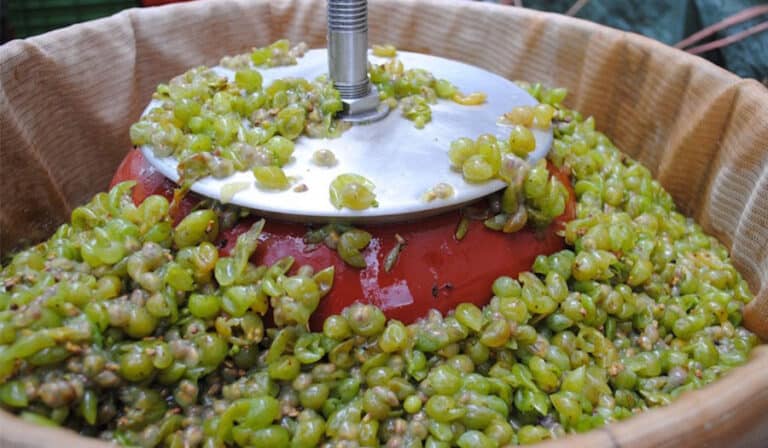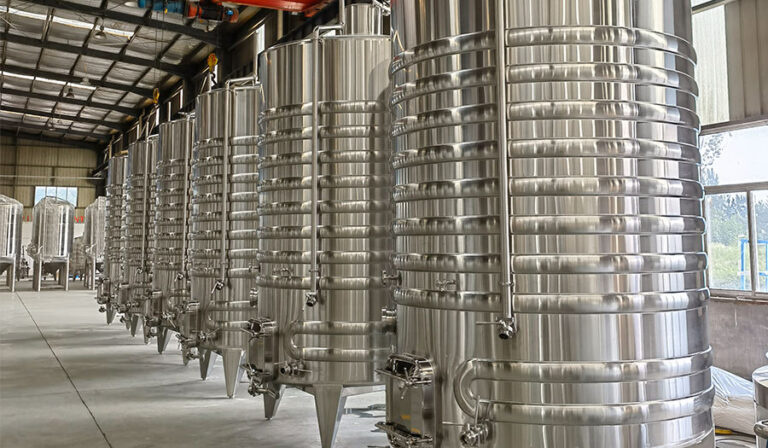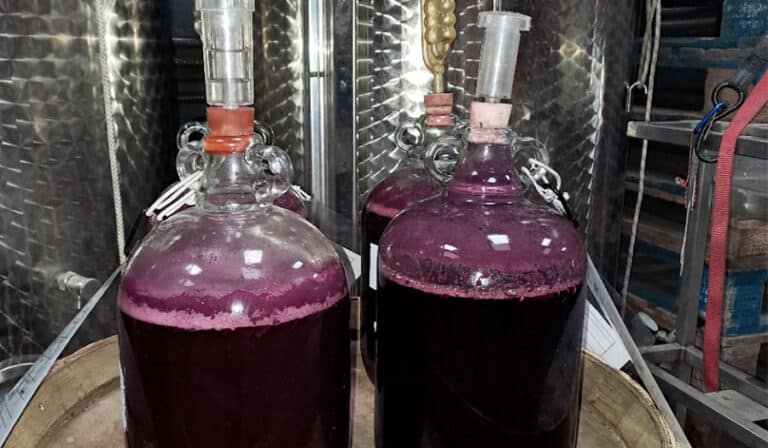초보자이든 숙련된 와인 메이커이든 와인을 만드는 것은 매력적인 취미입니다. 와인 제조 과정의 모든 단계에는 정밀한 조작과 전문성이 필요합니다. 와인 제조 장비 최종 와인의 품질과 풍미를 보장합니다. 따라서 와인 제조 공정에서 장비 선택은 매우 중요합니다. 와인 제조의 효율성을 향상시킬 뿐만 아니라 와인의 맛, 향 및 바디 특성을 결정하기도 합니다. 와인 제조 장비에는 다양한 종류가 있습니다. 초기 포도 수확부터 최종 병입까지 각 단계는 분쇄기, 발효 탱크, 프레스, 필터 등의 전문 장비로 지원됩니다. 이 장비는 와인 제조 공정의 원활한 진행을 보장할 뿐만 아니라 와인의 풍미와 스타일에도 중요한 영향을 미칩니다.
포도 따기
와인 양조는 포도 수확으로 시작되며 수확 시기는 와인의 품질에 결정적인 영향을 미칩니다. 일반적으로 포도가 완전히 익었을 때 수확하며, 이때 포도의 당도와 산도가 가장 좋은 균형을 이룹니다. 포도 수확에는 수동 수확과 기계 수확의 두 가지 방법이 있습니다. 수동 수확은 포도를 더 신중하게 선택하고 덜 익거나 썩은 과일이 섞이는 것을 피할 수 있기 때문에 고품질 와인 생산에 자주 사용됩니다. 기계식 수확은 일반적으로 대규모 포도밭에 적합하며 더 효율적이지만 선택의 세밀함을 달성하지 못할 수 있습니다.

포도 선별 및 탈색
최고 품질의 포도만 다음 단계로 넘어갈 수 있도록 수확 후 포도를 선별하고 껍질을 벗겨야 합니다. 선별의 목적은 썩었거나 너무 익었거나 병든 포도를 제거하는 것입니다. 고급 와인의 경우 일반적으로 모든 포도가 기준을 충족하는지 확인하기 위해 수작업으로 선별합니다. 데스템밍은 특히 레드 와인의 경우 포도 줄기를 제거하는 것을 말합니다. 포도 줄기가 발효 중에 와인에 섞이면 쓴맛을 유발할 수 있기 때문에 이 단계는 매우 중요합니다.
포도 분쇄 및 압착
선별과 탈착을 마친 포도는 주스를 추출하기 위해 분쇄와 압착을 거쳐야 합니다. 분쇄는 기계 장비를 통해 포도 껍질과 과육을 부드럽게 부수는 것이고, 압착은 과육에서 주스를 짜내는 것입니다. 이 과정은 와인의 종류에 따라 다릅니다:
- 레드 와인: 적포도주 생산 시 일반적으로 포도 껍질과 포도 주스가 함께 발효되므로 분쇄된 포도 과육(포도 껍질 포함)이 발효 탱크에 함께 들어갑니다.
- 화이트 와인: 화이트 와인은 일반적으로 분쇄 후 포도 껍질과 주스를 분리하고 주스는 발효 탱크로 직접 보내지며 포도 껍질은 와인과의 접촉을 피하기 위해 압착되어 신선한 맛을 유지합니다.
발효
발효는 와인 제조에서 가장 중요한 단계 중 하나입니다. 포도 주스의 당분을 알코올로 전환하는 과정입니다. 발효는 효모에 의해 완료되며, 효모는 설탕을 알코올과 이산화탄소로 분해하여 다양한 맛과 향을 내는 물질을 생성합니다.
- 레드 와인: 레드 와인의 발효는 일반적으로 포도 껍질이 있는 상태에서 진행되며, 이는 더 많은 색소와 타닌을 추출하여 와인을 더 강렬하고 풍부하게 만들 수 있습니다. 발효 과정은 일반적으로 색소와 타닌의 추출을 촉진하기 위해 더 높은 온도(보통 25~30°C)로 온도 제어 조건에서 수행됩니다.
- 화이트 와인: 화이트 와인의 발효는 일반적으로 포도의 신선한 과일 향을 보존하기 위해 저온(15~20°C)에서 진행됩니다. 발효 시간은 효모가 포도즙의 당분을 완전히 전환할 수 있도록 보통 몇 주가 걸리는 긴 시간입니다.
압착 및 분리(주로 레드 와인용)
레드 와인의 발효가 완료되면 일반적으로 포도 껍질, 과육, 와인 및 씨앗이 함께 혼합됩니다. 이때 포도 껍질에서 와인을 더 짜내기 위해 2차 압착이 필요합니다. 압착 후 포도 껍질은 분리되고 와인은 계속 가공됩니다.
- 2차 압착: 유압식 또는 공압식 프레스를 사용하여 발효된 포도 껍질을 눌러 더 많은 와인을 추출합니다.
- 분리: 발효가 완료된 후 와인의 투명도와 순도를 보장하기 위해 침전 또는 원심분리를 통해 와인의 고체 물질(포도 껍질, 씨앗 등)을 제거해야 합니다.
설명 및 필터링
와인 발효가 완료된 후에도 와인에는 여전히 효모, 펙틴 또는 기타 작은 입자가 남아있을 수 있으므로 와인을 맑게 하고 여과해야 합니다. 이 과정의 목적은 불순물을 제거하고 와인을 더 맑고 투명하게 만드는 것입니다.
노화
Aging is an important part of the winemaking process. It helps the wine mature and stabilize and gives the wine a more complex flavor. Depending on the type of wine and the winemaker’s style preference, different containers, and methods can be selected for aging. Some wines (especially white wines) will choose to age in stainless steel tanks to keep the wine fresh and fruity and avoid too much oak flavor.

와인 제조에 필요한 주요 장비
포도 수확 및 선별 장비
포도 수확은 와인 제조 과정의 첫 번째 단계이자 가장 중요한 연결 고리입니다. 수확 시기는 와인의 품질을 직접적으로 결정합니다. 전통적인 수작업으로 포도의 무결성을 보장할 수 있지만 와인 제조 규모가 증가함에 따라 기계화된 수확은 피할 수 없는 추세가 되었습니다.
- 기계식 피커: 이 장비는 포도가 익었을 때 빠르게 수확할 수 있으며, 특히 넓은 포도밭에 적합합니다. 기계식 피커에는 일반적으로 여러 개의 진동 암이 포함되어 있으며, 이 진동 암이 포도나무에서 포도를 따서 적재 칸으로 보냅니다.
- 선별 장비: 포도는 수확 후 부적합한 포도(예: 너무 익었거나 썩었거나 병든 과일)를 제거하기 위해 선별해야 합니다. 최신 선별 장비에는 일반적으로 선별 효율성을 높이기 위해 진동 스크린과 수동 선별 테이블이 장착되어 있습니다.
포도 파쇄 및 압착 장비
포도를 따고 나면 다음 단계는 분쇄와 압착 과정입니다. 분쇄는 포도 껍질과 과육을 분리하는 것이고 압착은 포도즙을 추출하는 것입니다. 와인 종류에 따라 이 두 단계의 가공 방법이 다릅니다.
- 포도 분쇄기: 분쇄기는 회전하는 칼날로 포도를 부드럽게 자르며, 일반적으로 너무 많은 구덩이가 생기지 않도록 완전히 분쇄하지 않습니다. 레드 와인의 경우 분쇄된 포도 과육이 포도 껍질과 함께 발효되는 반면, 화이트 와인의 경우 일반적으로 포도 과육이 포도 껍질에서 분리됩니다.
- 포도 프레스: 포도 프레스는 포도 과육에서 액체(예: 포도 주스)를 짜내는 데 사용됩니다. 다양한 유형의 프레스가 있으며 가장 일반적인 것은 에어백 프레스, 유압 프레스 및 스크류 프레스입니다. 화이트 와인은 일반적으로 포도 껍질과의 접촉 시간을 줄여 신선한 맛을 유지하기 위해 더 부드러운 압착 장비를 사용합니다.
포도 분쇄 및 압착
선별과 탈착을 마친 포도는 주스를 추출하기 위해 분쇄와 압착을 거쳐야 합니다. 분쇄는 기계 장비를 통해 포도 껍질과 과육을 부드럽게 부수는 것이고, 압착은 과육에서 주스를 짜내는 것입니다. 이 과정은 와인의 종류에 따라 다릅니다:
- 레드 와인: 적포도주 생산 시 일반적으로 포도 껍질과 포도 주스가 함께 발효되므로 분쇄된 포도 과육(포도 껍질 포함)이 발효 탱크에 함께 들어갑니다.
- 화이트 와인: 화이트 와인은 일반적으로 분쇄 후 포도 껍질과 주스를 분리하고 주스는 발효 탱크로 직접 보내지며 포도 껍질은 와인과의 접촉을 피하기 위해 압착되어 신선한 맛을 유지합니다.
발효설비
발효는 와인 제조에서 가장 중요한 과정 중 하나입니다. 이 과정에서 효모는 포도즙의 당분을 알코올과 이산화탄소로 전환하여 와인의 향과 풍미를 만들어냅니다. 와인 종류(레드 와인, 화이트 와인, 스파클링 와인)에 따라 발효 과정에서 사용하는 장비가 다릅니다.
- 발효 탱크: 현대 와인 제조에서는 일반적으로 스테인리스 스틸 또는 오크 발효 탱크가 사용됩니다. 발효 탱크의 크기와 모양은 와인의 발효 과정에 큰 영향을 미칩니다. 발효 탱크에는 원통형과 타원형의 두 가지 일반적인 형태가 있습니다. 스테인리스 스틸 발효 탱크는 현대적인 대규모 생산에 더 적합하며 와인과 화학적으로 반응하기 쉽지 않아 와인의 순도를 보장합니다.
- 온도 제어 시스템: 온도는 효모의 활동에 매우 중요하므로 발효 탱크에는 일반적으로 발효 과정이 최적의 온도에서 이루어질 수 있도록 온도 제어 시스템이 장착되어 있습니다. 온도가 너무 높으면 효모가 조기에 죽을 수 있고, 너무 낮으면 불완전 발효로 이어질 수 있습니다.
압착 및 분리 장비(레드 와인 전용)
레드 와인의 경우 발효 후 일반적으로 더 많은 색소, 타닌 및 풍미 물질을 추출하기 위해 포도 껍질을 압착합니다. 이때 과도한 압착은 와인에 너무 많은 쓴맛을 유발할 수 있으므로 압착 장비의 선택이 매우 중요합니다.
- 2차 프레스: 일반적으로 와인의 추출을 극대화하고 포도 껍질의 과도한 손상을 방지하기 위해 2차 압착에는 유압 프레스가 사용됩니다.
- 분리기: 발효 후 와인과 고체 물질(포도 껍질, 씨앗 등)을 분리해야 합니다. 분리기는 원심력 또는 중력을 사용하여 액체와 고체 부분을 분리합니다.
정화 및 여과 장비
발효 후 와인에는 일반적으로 일정량의 효모, 포도 잔여물 및 기타 불순물이 포함되어 있으므로 와인의 투명도와 투명성을 보장하기 위해 와인을 맑게 하고 여과해야 합니다.
- 청징제: 청징제는 와인의 부유 물질과 반응하여 더 큰 입자를 형성하여 결국 가라앉고 쉽게 제거할 수 있도록 합니다. 일반적인 청징제에는 단백질 청징제와 벤토나이트가 있습니다.
- 필터: 필터는 와인에 있는 작은 입자와 박테리아를 제거하는 데 사용됩니다. 플레이트 및 프레임 필터, 백 필터, 멤브레인 필터 등 다양한 유형의 필터가 있습니다.

노후화된 장비
숙성은 와인 제조에서 매우 중요한 단계로 와인의 풍미, 맛, 안정성을 향상시키는 데 도움이 됩니다. 와인의 스타일에 따라 숙성 장비는 달라질 수 있습니다.
- 오크통: 레드 와인과 일부 화이트 와인은 오크통에서 숙성되는 경우가 많습니다. 오크통은 와인의 독특한 풍미(바닐라, 연기, 향신료 등)를 제공할 뿐만 아니라 미량의 산소 교환을 통해 와인의 숙성을 촉진합니다. 오크통은 일반적으로 프렌치 오크와 아메리칸 오크로 나뉘며, 전자는 더 섬세하고 후자는 더 강한 풍미를 가지고 있습니다.
- 스테인리스 스틸 탱크: 신선함과 풍부한 과일 향을 추구하는 일부 화이트 와인의 경우, 현대 와인 메이커들은 와인의 순도와 본연의 맛을 유지하기 위해 일반적으로 숙성 시 스테인리스 스틸 탱크를 선택합니다.
병입 및 밀봉 장비
완성된 와인은 최종적으로 소비자에게 제공되기 전에 병입 및 밀봉 공정을 거쳐야 합니다. 병입 공정에 사용되는 장비에는 주로 병입 기계, 병 밀봉 기계, 라벨링 기계가 포함됩니다.
- 보틀링 머신: 병입 기계는 와인을 와인 저장 탱크 또는 오크통에서 병으로 옮깁니다. 병입 시 와인이 공기에 의해 오염되지 않도록 해야 하므로 많은 병입 장비에는 진공 장치가 장착되어 있습니다.
- 병 마개 기계: 병 마개 기계는 병 입구에 코르크를 추가하는 데 사용됩니다. 일반적인 코르크에는 코르크, 플라스틱 코르크 등이 있습니다. 코르크는 일반적으로 고급 와인에 사용됩니다. 코르크는 와인을 잘 밀봉하고 소량의 공기가 들어갈 수 있도록 하여 와인의 숙성을 촉진합니다.
와인 장비 선택 시 주의해야 할 사항
- 포도 품종 및 와인 종류: 포도 품종과 와인 종류에 따라 필요한 장비의 요구 사항이 다릅니다. 예를 들어 레드 와인은 더 많은 발효 및 침식 장비가 필요한 반면 화이트 와인은 더 많은 온도 제어 및 필링 장비가 필요합니다.
- 생산 규모와 효율성: 대규모 와이너리에는 효율적이고 고도로 자동화된 장비가 필요하지만, 소규모 가족 와이너리에서는 수작업과 소형 장비에 더 집중할 수 있습니다.
- 장비의 재질과 내구성: 스테인리스 스틸, 오크 및 기타 재료로 만든 장비를 선택할 때는 내구성과 와인의 풍미에 미치는 영향을 고려해야 합니다.
- 위생과 손쉬운 세척: 와인 제조 과정에는 많은 양의 액체와 주스가 사용되므로 장비의 위생과 청소가 매우 중요합니다. 세척과 유지 관리가 쉬운 장비를 선택하면 와인 제조의 품질을 보장할 수 있습니다.
요약
와인 양조는 포도 수확부터 병입까지 여러 단계가 복잡하고 섬세하게 얽혀 있는 작업입니다. 각 링크에는 양조 과정의 원활한 진행과 와인 품질의 안정성을 보장하기 위해 해당 장비가 필요합니다. 과학적이고 합리적인 장비 구성을 통해 와인 메이커는 와인 제조 과정의 다양한 변수를 제어하고 궁극적으로 고품질 와인을 양조할 수 있습니다. 따라서 올바른 와인 제조 장비를 선택하면 생산 효율성을 향상시킬 뿐만 아니라 와인의 품질과 풍미를 효과적으로 보장할 수 있습니다.




